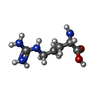+Search query
-Structure paper
| Title | De novo design of protein interactions with learned surface fingerprints. |
|---|---|
| Journal, issue, pages | Nature, Vol. 617, Issue 7959, Page 176-184, Year 2023 |
| Publish date | Apr 26, 2023 |
 Authors Authors | Pablo Gainza / Sarah Wehrle / Alexandra Van Hall-Beauvais / Anthony Marchand / Andreas Scheck / Zander Harteveld / Stephen Buckley / Dongchun Ni / Shuguang Tan / Freyr Sverrisson / Casper Goverde / Priscilla Turelli / Charlène Raclot / Alexandra Teslenko / Martin Pacesa / Stéphane Rosset / Sandrine Georgeon / Jane Marsden / Aaron Petruzzella / Kefang Liu / Zepeng Xu / Yan Chai / Pu Han / George F Gao / Elisa Oricchio / Beat Fierz / Didier Trono / Henning Stahlberg / Michael Bronstein / Bruno E Correia /    |
| PubMed Abstract | Physical interactions between proteins are essential for most biological processes governing life. However, the molecular determinants of such interactions have been challenging to understand, even ...Physical interactions between proteins are essential for most biological processes governing life. However, the molecular determinants of such interactions have been challenging to understand, even as genomic, proteomic and structural data increase. This knowledge gap has been a major obstacle for the comprehensive understanding of cellular protein-protein interaction networks and for the de novo design of protein binders that are crucial for synthetic biology and translational applications. Here we use a geometric deep-learning framework operating on protein surfaces that generates fingerprints to describe geometric and chemical features that are critical to drive protein-protein interactions. We hypothesized that these fingerprints capture the key aspects of molecular recognition that represent a new paradigm in the computational design of novel protein interactions. As a proof of principle, we computationally designed several de novo protein binders to engage four protein targets: SARS-CoV-2 spike, PD-1, PD-L1 and CTLA-4. Several designs were experimentally optimized, whereas others were generated purely in silico, reaching nanomolar affinity with structural and mutational characterization showing highly accurate predictions. Overall, our surface-centric approach captures the physical and chemical determinants of molecular recognition, enabling an approach for the de novo design of protein interactions and, more broadly, of artificial proteins with function. |
 External links External links |  Nature / Nature /  PubMed:37100904 / PubMed:37100904 /  PubMed Central PubMed Central |
| Methods | EM (single particle) / X-ray diffraction |
| Resolution | 2.63 - 3.29 Å |
| Structure data | EMDB-14922, PDB-7zrv: EMDB-14930, PDB-7zsd: EMDB-14947: cryo-EM structure of D614 spike in complex with de novo designed binder, full and local maps(addition)  PDB-7xad:  PDB-7xyq: |
| Chemicals |  ChemComp-ARG:  ChemComp-HOH:  ChemComp-NAG: |
| Source |
|
 Keywords Keywords | IMMUNE SYSTEM / PD-L1 / ANTIVIRAL PROTEIN / SARS-COV2 / de novo / design binder / spike / RBD / receptor binding domain |
 Movie
Movie Controller
Controller Structure viewers
Structure viewers About Yorodumi Papers
About Yorodumi Papers











 homo sapiens (human)
homo sapiens (human)